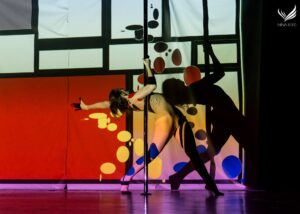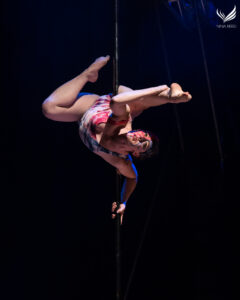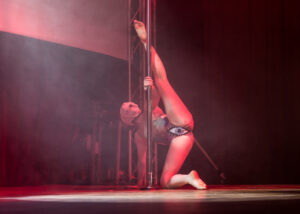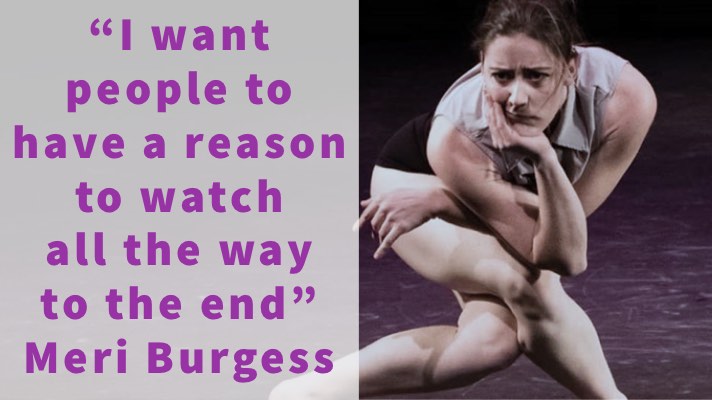An Interview with Meri Burgess
 Meri discusses the foundation of her pole dance practice and how after only two years of training, she began teaching and performing in pole dance. I was excited to learn about Meri’s Inanimate Dance Organization as I believe it can reframe the ways in which the artist meet their chosen apparatus (the pole, in her case). Her reflection from the first piece of work she made was relatable and probably very helpful for those of you who are confused about what a choreographic process entails. The overall interview also addresses subconscious inspiration, the value of finding a choreographer to add thoughts from an external perspective and how her life, working in a corporate job, informed one of her dance works. I am sure you will enjoy this interview as much as I did.
Meri discusses the foundation of her pole dance practice and how after only two years of training, she began teaching and performing in pole dance. I was excited to learn about Meri’s Inanimate Dance Organization as I believe it can reframe the ways in which the artist meet their chosen apparatus (the pole, in her case). Her reflection from the first piece of work she made was relatable and probably very helpful for those of you who are confused about what a choreographic process entails. The overall interview also addresses subconscious inspiration, the value of finding a choreographer to add thoughts from an external perspective and how her life, working in a corporate job, informed one of her dance works. I am sure you will enjoy this interview as much as I did.
Tell us a bit about yourself
I am from and currently reside in Boulder, Colorado, USA, where I work as a software developer by day and performer and instructor by night/weekend.
I started dancing in 2012 while living in Southern California. I was 20 years old, an art geek couch potato, and had never been an athletic or movement oriented person, but I wanted to improve my health and lifestyle. I stumbled across a discount deal for pole dance classes online one day, and I thought it would make me seem edgy and cool to be a pole dancer, so I went. The studio I went to did not focus on a lot of tricks or technique, instead it was mostly about how your movement made you feel. It spoke to me on a really deep level and I was hooked. I often wonder if I would have stuck with it if I had started at a typical studio—I think a more athletic approach would have scared me off! My training proceeded pretty rapidly and eventually I enrolled at the Frequent Flyers professional training program for aerial dance in 2014, which is where I really built out my dance foundation, both in the air and on the ground. After I graduated that program, my “professional” career really began and I started teaching and performing regularly.
About a year and a half ago, I also started an organization called Inanimate Dance, which is primarily a vehicle for running Inanimate 48. Inanimate 48 is 48 hour aerial choreography meets dance film contest. The basic premise is that participants have 48 hours to choreograph and film a brand new piece of work on the apparatus of their choice. A panel of curators comes in to select a few honourable mentions and one prize winner. We also donate part of the registration proceeds to different charities. I created the “rules” of Inanimate 48 to be as loose as possible—you can do any length of time, any number of people, apparatus, props, location, skill level, video editing, and style—because I have often found myself frustrated by limitations of competitions and paying clients. It’s meant to be a celebration of possibilities in aerial dance. Inanimate 48 is one of my main side-projects these days.
When did you create your first piece of work?
I made my first piece the same year I started dance. I had been pole dancing for about 8 months. I was already an artist at the time—I was in art school studying classical animation—so I had a very natural urge to want to create something. I signed up for the PSO Pacific Pole Championships in 2013. I remember being a bit baffled by what the choreography process was supposed to be. I thought, “What so I just…pick some moves and put them together?” It felt too easy, like there was something special I was supposed to be doing and totally missing. Of course, you can get really deep into the picking of the moves and why, but it turns out that IS all it really is, haha. I’m still really proud of that piece. For my level of experience at the time, I think it was really impressive.
 What tends to stimulate your creative thoughts?
What tends to stimulate your creative thoughts?
I think a lot of my best ideas or most creative moments have come in times when my more conscious brain is at rest, like being half asleep or lost in a long, long freestyle session. I’ve also had some brilliant moments just trying to get people to laugh or have a reaction while goofing around with friends.
In terms of conceptual inspiration, I like to observe small nuances of human behaviour and structures of society and nature. I am particularly obsessed with analysing value systems in art and dance, or in other words, why we have agreed upon particular aesthetics and forms as ideals. I really like picking this apart and trying to understand things from a comprehensive perspective. I’m also heavily influenced by my own emotional reactions to the world around me, as most artists are.
What is your favourite part of the creative process?
I think the most satisfying part of the creative process are the spontaneous little discoveries I have along the way. Like when I am practicing something a lot and one time I do a little part different and realize “Oh! That could be a whole special thing!” and suddenly it ties the threads of the dance together in a new way that I hadn’t planned on. I feel like a creative genius in those moments.
What do you find most difficult about choreography and how do you overcome this?
I struggle with cleaning choreography. I am a very freestyle driven dancer, so my tendency is to do things a little different every time and just make it work along the way. But that doesn’t help when I want a piece that has the level of detail and musicality I am striving for. I think the most useful thing for me has been to hire an artistic coach. It’s like a muscle I haven’t developed yet and I need a trainer to help me build up strength there. Just like when we hire a coach to help us get stronger or more flexible, I believe that finding someone who is skilled at the stage of the process you are struggling with will help you learn and grow your own skill set there. I hope that eventually I can build my “cleaning” muscles and one day it will come more naturally.
Who is your biggest inspiration and why?
I don’t know if there is any one person that tops all others across the board. I have so many inspirations for different things. In dance, many of my inspirations are people I train with and watch on a regular basis. It is good to be regularly reminded of how many different ways there are to move. There is one dancer that jumps to the forefront of my mind, though, when I think about inspiring performance, and that would be Outrage, who is a krumper from the LA area. I’ve never seen anyone dance with such an ultimate presence and intention before. I’ve never seen anyone make a crowd so hyped before, what he does as a performer is indescribable. I aspire to his level of conviction in movement.
What, if any, do you think are the psychological benefits of creating your own work?
When I started dancing, I was in a really challenging mental place. Even though I was an artist, I had a difficult time truly expressing myself through words or images. I put pressure on myself to not be too melodramatic because I didn’t want to be annoying or cliché. Dance as a medium was life changing. It’s interpretive to other people and you can be melodramatic AF and that’s, I dunno, normal. Good, even. There is something so non-judgemental about personal emotions in dance. Creating my own work lets me process and share a lot of what I am going through in a safe and supportive space.
You sent us ““Where the Heart Is,” Can you tell us how you prepared for this work and what your process was like?
Oh geez! I have a lot to say about this one as I put a lot of thought into the process (side note: I once took a college class called “Looking at Dance” and wrote a lot of essays about dance and I think it shows).
This piece was done for PSO Northwest in 2019 to a piece of spoken word from Kate Tempest titled “Where the Heart Is.” The first time I heard the track, it hit me in the heart like a brick. I’ve been performing semi-professionally for several years, but I still went through college and chose to take on a full-time office job in 2018—all while watching a lot of my friends frolic (and struggle) through full time circus and dance careers. Having a corporate job is existentially challenging sometimes; I constantly worry if I am making the right choice. This track is like a manifestation of my concerns for myself.
The melodic and rhythmic way the Tempest speaks is so intricate and beautiful, I wanted to be right there with that in the choreography. Like I mentioned, I am not great at cleaning details, so for the first time ever, I hired a coach to work with me from start to finish because I wanted that extra push. I worked with Sarah “Towel” Touslee, a really awesome mixed styles dancer from Colorado. We met up for 6 sessions over the course of about 7 weeks. I picked out all of the pole skills and she helped me refine details, musicality, and character choices. Sarah has an incredible ear for music and such a fresh, unique style that having her be a part of the process allowed me to expand my abilities a lot. I specifically sought out someone who was a dancer, but not a pole dancer, because I wanted that focus. Tricks don’t matter in an artistic performance, and I didn’t need help with them, I needed help with the dance.
During the process I also did a lot of journaling. I wrote out all the lyrics and highlighted key words with a color coding corresponding to the categorical sentiments I thought was reflected behind them. I wrote about how the song made me feel about my own life, and why I wanted to tell the story, all of which helped me decide the narrative.
In the piece, I created one particular phrase of movement to repeat in multiple places, but every time in different variations. I wanted this to be a reflection of monotony and how we repeat a lot of stuff in our lives. It feels different on the surface, but at the core, it is the same. Sometimes it annoys me how pole pieces always cram as many unique skills as possible into one performance—why do we place so much value on versatility? I wanted to show that it can be compelling to repeat something—there is more than just movement there. Even if we do different movements throughout the routine, it often feels the same anyway. It’s exhausting as a dancer, and on top of that, the audience doesn’t care. I can’t count how frequently I get two minutes through a pole video and toggle my screen to see how much is left. It’s always at the 2 minute mark. Most of the time, that is the point where I’ve felt I’ve seen everything I need to see in a performance—I know there won’t be anything new. Maybe that is a harsh or cynical thing to admit, but it’s the truth. This is what drove me in this piece and continues to drive my choreography always: I want people to have a reason to watch all the way to the end.
 If you haven’t already mentioned it in a previous answer, what comes first during your process, the pole or the floor movement?
If you haven’t already mentioned it in a previous answer, what comes first during your process, the pole or the floor movement?
Pole movement usually comes first, specifically the aerial movements, because they are so technical. I have to make sure that I can adequately do what I want within the right time frame. I find floor work more difficult to pin down, because the possibilities are so open. There’s no restriction created by an apparatus, you can do whatever you want on the floor! It’s paralyzing sometimes.
Really though, I start first with blockier chunks throughout, kind of like sculpting out of a big slab of marble. You carve out the general shape of the piece first, like where on stage you want to spend for which parts of the songs and setting an intention for the general mood or theme of the movement, and then slowly fill in the details—first with the base movement, then the qualities and accents.
Since creating your first solo, how do you think you have grown as a choreographer?
I think I have matured considerably since that first piece in 2013. A lot of my movement then was just mimicking what I had done in my handful of mostly sensual based pole dance classes. I have trained in a large variety of different dance styles and movement disciplines since, and absorbed and reconnected them to define my own unique style. I never try to be anyone but myself.
If you could give readers a piece of advice for creating their dance, what would it be?
No one remembers WHAT you do, but they will remember HOW you do it. Unless you are at the pinnacle of strength, acrobatics, or flexibility, people probably have seen the underlying skills of your performance before, and if you don’t add a unique quality, narrative, or personality to it, frankly, it will end up being forgettable and boring. Adding that layer takes work, it doesn’t happen instantly, so I recommend spending just as much time training skills as you do training conceptual exploration, different movement qualities, and acting.
If you were hiring a dancer to perform your work, what would you look for in them?
The number one thing I’d look for is reliability. Show up when you say you will. Put in the work. The next thing I’d look for would be a confident stage presence, someone who is comfortable and able to connect with their emotions and show them to an audience. Everything else I think could be taught and learned. But reliability and stage presence—those have to come from you.
What sort of time frame do you give yourself to create a new piece of work?
For a piece where I really want to explore something new and be proud of my work, I need around 6-12 weeks of 3-5 sessions a week. Half of that time I ideally spend on exploration and choreography, and the other half on cleaning and practicing. I probably do not absolutely NEED that much time. I can and have at times created a new piece within 2-4 hours, if I’ve got a gig or something that week and need to create something fast, but that work is usually a little more basic, probably slightly freestyled, and not so innovative or imbued with style. I find allowing things to sit for a while and exploring the movement over and over again increases that chance that I will have creative revelations and add finer details later on.
Finally, what does pole dance do for you?
It has given me a community of supportive, creative, fantastic people. I’ve made friends all over the world because of pole! It’s so cool! Pole dancing is like home to me. I think it’ll be a through-line of my life. It’s been interesting to use it as a mirror for my own personal growth as an adult, and I’m curious and excited to see where it all goes.
If you would love to keep up to date with Meri’s artistry, you can find her on Instagram: @meriburgess, @inanimate.danceor visit her website: www.inanimatedance.com
Rowena x
Don’t forget to check out Choreography Cards for tons of creative pole fun.




No Comments